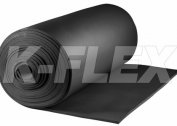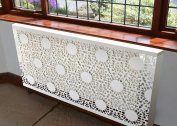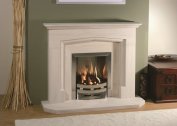The main task of the sauna stoves is to create a comfortable microclimate in the steam room. When operating in the maximum heat transfer mode, the device walls can heat up to 400 ° С, which negatively affects fire safety and increases the likelihood of thermal burns to the arms and body. To prevent these troubles, many attendants use a protective screen for the stove in the bathhouse.
When do you need a protective screen
In addition to protection against burns, the use of heat-resistant structures allows you to block the effects of dangerous infrared rays that are released as a result of overheating of the metal walls of the heating device. At the same time, a protective screen for the bath stove makes it possible to solve a number of other problems:
- control of convection flows of hot air, contributing to uniformly warm the steam room;
- increased heat transfer time after completion of the procedures, which helps to dry the steam room faster;
- Reducing the risk of fire by preventing the walls from heating to critical temperatures.
Another task of protective screens is to perform a decorative function. Not all heating systems have a pleasant aesthetic appearance against the background of the steam room interior. A special heat-resistant partition is able to give the bath a neat and stylish look.
What materials are made
Safety shields are installed in saunas that have metal stoves. In the presence of brick structures, these devices are not needed. It is enough to make sure that there is an air gap between the stove and the wall.
During the manufacture of the partition walls, exclusively heat-resistant materials must be used. These include wood, brick, stainless steel.
Wood
This material is used during the manufacture of decorative fences, which will not allow vacationers to get too close and get burns. Wooden partitions should be located no less than half a meter from the heater. When darkening occurs on wood, they need to be moved further away.
Brick
Such partitions should be 20-30 cm higher than the heating system. At the bottom of the structure, gaps must be left that allow air exchange between the screen and the heater. If necessary, they can be blocked with furnace doors.
When laying a protective screen, it is recommended to use fireclay bricks. The solution is made on the basis of clay or cement. The thickness of the masonry can be 6-12 cm. The distance from the partition to the furnace should be at least 5 cm. The same distance must be observed between the walls of the bath and the screen.
Stainless steel
The protective design for the stove in the bath can be made of stainless steel. This is the best option among all types of screens for bath stoves, since it fully reflects the heat in the steam room. Steel partitions are capable of overheating, so they are supplemented by backfill of crushed stone, expanded clay or broken brick.
The metal fencing for the furnace in the steam room is installed in the form of a box or fixed in the corner between the heater and the wall. The distance between the screen and the oven should be at least 12 cm.
How to make a screen for the stove in the bath
The technology for creating and installing the fence depends on the material used. Brick masonry is half or a quarter of a brick wide.In the second case, the load on the foundation will be less, but this reduces the heat capacity and structural strength. When choosing a type of construction, several important details must be taken into account:
- bearing capacity of flooring;
- maximum oven heating temperature;
- the desired rate of heating the room;
- openness or isolation of the top of the structure.
For masonry, a solid brick is best suited. Due to the high heat capacity, the room dries faster after use. Masonry mortar can be purchased at a hardware store or prepared independently. It is made on the basis of sand and oily clay. You can add 10% cement to it, which will increase the strength of the future design.
During the independent production of a protective screen for the furnace equipment in the bathhouse or sauna, it is necessary to prepare the appropriate set of tools:
- apparatus for welding;
- grinder with a cutting disc;
- respirator;
- gloves
- plumb line;
- building level;
- hammer;
- Master OK.
The first stage of construction is the preparation of the foundation. If the floorboards in the bath are unable to cope with the weight of the stove and the protective structure, the floor is disassembled under them and the foundation pit is rummaged to create a solid foundation. When installing additional reinforcements on the foundation, it is necessary to lay a sheet of thermal insulation or minerite. The base can also be used steel sheets and ceramic tiles.
After that, you need to choose the material that will become the basis of the future protective screen for the stove in the bathhouse. The best option is stainless steel. From solid sheets of metal, the structure body is cut out and welded. After that, a steel pole with a smaller size is welded, which is installed inside to create a heater.
Next, it is necessary to weld an oblong duct for the chimney and weld an additional container for heating water. In this case, the tank with the heater should fit inside the housing. Then cut a hole in the front wall of the housing, which will allow access to the furnace door, after which the legs are riveted to the bottom.
In the case of using bricks, the masonry is made 5-10 mm from the walls of the heating apparatus, so that a channel forms that will be used to remove hot air. The lower part of the structure must be left with small gaps. In this case, it is necessary to carefully control the evenness of the screen with the help of plumb lines and building level. The last step in the installation of the structure is the installation of a canopy or mesh.
The gaps at the bottom of the protective screen are necessary to create air exchange, which will make it possible to increase the efficiency of the heating system. However, they will not reduce the heat capacity of the brick structure.
Holes are often equipped with special doors. When closed, they contribute to the accumulation of heat in the masonry of the protective screen, and when open, they quickly heat the room.
Common mistakes
During the independent creation and installation of the structure at home, novice masters often make mistakes. Among them, the most common are:
- the lack of a sufficient distance between the structure and the walls of the steam room negatively affects the degree of strength of the masonry and fire safety;
- the lack of distance between the walls of the furnace and the brick, which contributes to the violation of air exchange, overheating of the protective screen and cracking of masonry;
- poorly mixed masonry mortar leads to crumbling of masonry, the appearance of cracks and the formation of unnecessary gaps.
The technology for creating and installing a protective screen is quite simple. For this reason, even beginners in the construction business can cope with it.
The protective fence favorably affects the efficiency of the heating device located in the middle of the steam room or in the corner of the room. Self-assembly of this type of structure does not require a lot of time and money, and also improves the functionality of the bath and its appearance.









